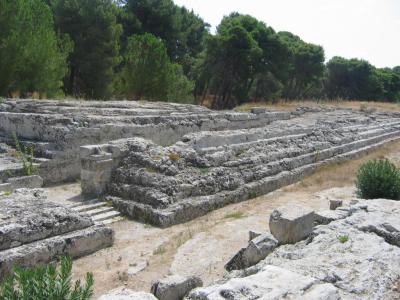Ara di Ierone (Altar of Hiero II), Syracuse
The Altar of Hiero II is a remarkable archaeological site, although much of its upper structure has been lost to history. This monumental altar occupies a prominent position in ancient Neapolis, and today, mainly the basement structures remain, nestled into the lower part of the rocky slope of Colle Temenite. The original upper block structure, once a significant part of this grand monument, was nearly entirely removed during the 16th century to be repurposed in the construction of the Spanish fortifications in the city.
The historical significance of the altar's location is evident as it was originally believed to be associated with a building dedicated to Zeus Eleutherios, the "liberator." In front of this altar, a rite was celebrated following the expulsion of the last tyrant of the Dinomenids, Thrasybulus of Syracuse, in 466 BC. The rite in honor of Zeus Eleutherios, during the festivals known as Eleutheria, is said to have included athletic competitions and the sacrifice of 450 bulls. Diodorus, the historian, attributes the construction of this grand work to Hieron II, and it was described as being stadium-sized and built in proximity to the theater.
The surviving portions of the Altar of Hiero II include its immense rocky base, which measures approximately 198 meters in length and 22.80 meters in width. Notably, the northern half of this base rests upon a vast underground cavity, which may have been of natural origin or used for rock extraction before the altar's construction.
The altar featured two symmetrical and opposing ramps at its front ends, providing access to the central platform where sacrificial ceremonies took place. Each of these ramps was preceded by an entrance, with the northern entrance flanked by two Telamons, and the feet of these sculptures have been preserved. The altar stands as a testament to the historical and religious significance of Syracuse in antiquity, and despite the loss of its upper structure, its surviving components offer valuable insights into the cultural practices and grandeur of ancient times.
The historical significance of the altar's location is evident as it was originally believed to be associated with a building dedicated to Zeus Eleutherios, the "liberator." In front of this altar, a rite was celebrated following the expulsion of the last tyrant of the Dinomenids, Thrasybulus of Syracuse, in 466 BC. The rite in honor of Zeus Eleutherios, during the festivals known as Eleutheria, is said to have included athletic competitions and the sacrifice of 450 bulls. Diodorus, the historian, attributes the construction of this grand work to Hieron II, and it was described as being stadium-sized and built in proximity to the theater.
The surviving portions of the Altar of Hiero II include its immense rocky base, which measures approximately 198 meters in length and 22.80 meters in width. Notably, the northern half of this base rests upon a vast underground cavity, which may have been of natural origin or used for rock extraction before the altar's construction.
The altar featured two symmetrical and opposing ramps at its front ends, providing access to the central platform where sacrificial ceremonies took place. Each of these ramps was preceded by an entrance, with the northern entrance flanked by two Telamons, and the feet of these sculptures have been preserved. The altar stands as a testament to the historical and religious significance of Syracuse in antiquity, and despite the loss of its upper structure, its surviving components offer valuable insights into the cultural practices and grandeur of ancient times.
Want to visit this sight? Check out these Self-Guided Walking Tours in Syracuse. Alternatively, you can download the mobile app "GPSmyCity: Walks in 1K+ Cities" from Apple App Store or Google Play Store. The app turns your mobile device to a personal tour guide and it works offline, so no data plan is needed when traveling abroad.
Ara di Ierone (Altar of Hiero II) on Map
Sight Name: Ara di Ierone (Altar of Hiero II)
Sight Location: Syracuse, Italy (See walking tours in Syracuse)
Sight Type: Attraction/Landmark
Guide(s) Containing This Sight:
Sight Location: Syracuse, Italy (See walking tours in Syracuse)
Sight Type: Attraction/Landmark
Guide(s) Containing This Sight:
Walking Tours in Syracuse, Italy
Create Your Own Walk in Syracuse
Creating your own self-guided walk in Syracuse is easy and fun. Choose the city attractions that you want to see and a walk route map will be created just for you. You can even set your hotel as the start point of the walk.
Syracuse Introduction Walking Tour
Syracuse, a city steeped in 2,700 years of Greek and Roman history, boasts a rich cultural heritage, remarkable amphitheaters, and iconic architecture. It was the birthplace of the renowned mathematician and engineer Archimedes and played a pivotal role as a Mediterranean powerhouse in ancient times.
Founded by Ancient Greek Corinthians and Teneans, the city-state formed influential alliances... view more
Tour Duration: 1 Hour(s)
Travel Distance: 1.0 Km or 0.6 Miles
Founded by Ancient Greek Corinthians and Teneans, the city-state formed influential alliances... view more
Tour Duration: 1 Hour(s)
Travel Distance: 1.0 Km or 0.6 Miles
Neapolis Archaeological Park Walk
For those keen on ancient history, Syracuse's main attraction lies within its Neapolis Archaeological Park. Spread across a vast area, this historical site contains a variety of fascinating landmarks, each with its own unique story.
Our first stop on this walk is the Augustan Arch (Arco Augusteo), the majestic archway built during the reign of Emperor Augustus. Nearby, you'll find the... view more
Tour Duration: 2 Hour(s)
Travel Distance: 2.1 Km or 1.3 Miles
Our first stop on this walk is the Augustan Arch (Arco Augusteo), the majestic archway built during the reign of Emperor Augustus. Nearby, you'll find the... view more
Tour Duration: 2 Hour(s)
Travel Distance: 2.1 Km or 1.3 Miles





